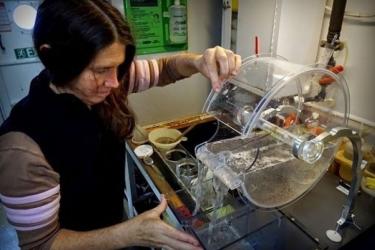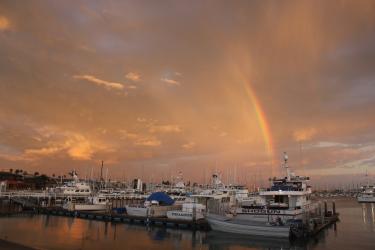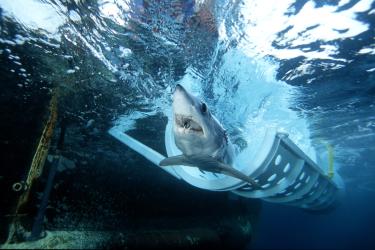West Coast Coastal Pelagic Species
West Coast Coastal Pelagic Species

Quick Facts
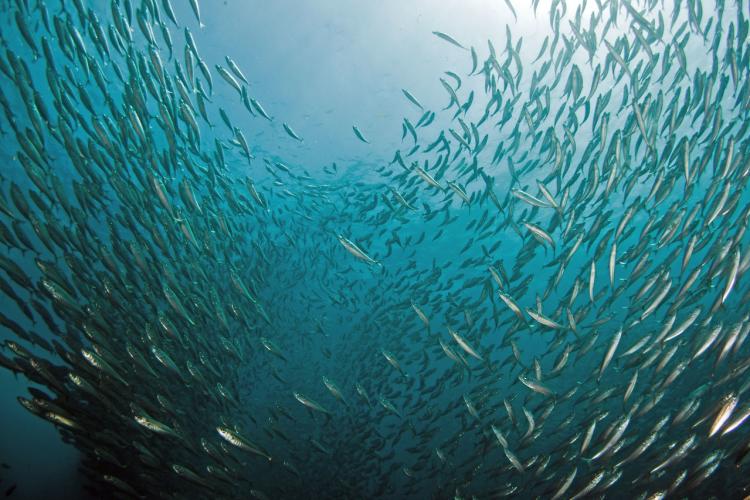 Jack mackerel schooling around Ship Rock
Jack mackerel schooling around Ship Rock
Jack mackerel schooling around Ship Rock
About
 Jack mackerel schooling around Ship Rock
Jack mackerel schooling around Ship Rock
Jack mackerel schooling around Ship Rock
“Coastal Pelagic Species” on the West Coast include Pacific sardine, Pacific mackerel, jack mackerel, northern anchovy, market squid, and krill. CPS live in the water column, as opposed to living near the sea floor, at depths from the surface to 1,000 meters (547 fathoms) deep, typically above the continental shelf.
West Coast CPS play an important role in the California Current ecosystem as a food source for marine mammals, sea birds, and larger fish, and support various commercial and recreational fisheries.
Population Status
For information on CPS stock abundance, population trends, and historical fishery landings, see the current Stock Assessment and Fishery Evaluation Report.
Biology
For background information on CPS biology, visit the Pacific Fishery Management Council webpage, as well as our species pages for Pacific sardine, Pacific mackerel, northern anchovy, and market squid.
Management Overview
Stocks in the CPS Fishery Management Plan are actively managed, monitored, and prohibited harvest species. The purpose of active and monitored management is to use agency resources in the most efficient and effective manner while satisfying goals and objectives of the fishery management plan. The distinction enables managers and scientists to concentrate efforts on stocks and segments of the CPS fishery that need the greatest attention or where the most significant benefits might be expected.
Both actively managed and monitored species may be subject to active management measures such as catch allocation, gear regulations, closed areas, or closed seasons.
Actively Managed
Active management is characterized by periodic stock assessments or adjustments of target harvest levels.
- Pacific sardine (Sardinops sagax)
- Pacific (chub) mackerel (Scomber japonicas)
Monitored
Monitored management involves tracking landing against respective annual catch limits and qualitative comparison to available abundance data, but without periodic stock assessments or likely annual adjustments to target harvest levels.
- Northern anchovy, central and northern subpopulations (Engraulis mordax)
- Market squid (Doryteuthis opalescens)
- Jack mackerel (Trachurus symmetricus)
Prohibited Harvest
- Krill or Euphausiids (8 dominant species)
- Euphausia pacifica
- Thysanoessa spinifera
- Nyctiphanes simplex
- Nematocelis difficilis
- Thyanoessa gregaria
- Euphausia recurva
- Euphausia gibboides
- Euphausia eximia
The CPS Fishery Management Plan includes a management framework designed to react quickly to changes in the fisheries and stocks, with the Pacific Fishery Management Council's (Council) CPS Management Team providing advice on the classification changes in accordance with fishery and stock dynamics.
Last updated by NOAA Fisheries on 03/11/2025
Featured News
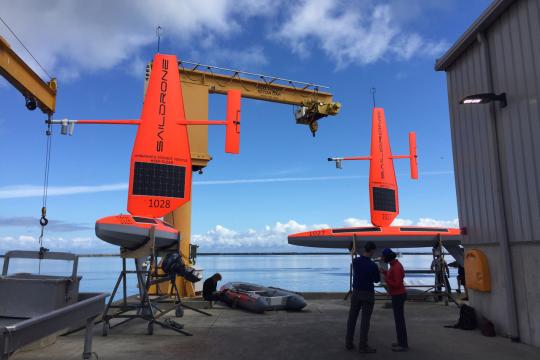
Commercial Fishing Regulations
The Coastal Pelagic Species commercial fishery is a multi-species fishery where fishermen typically switch between various CPS depending on market conditions, availability of the target CPS stocks to the fleet (distance offshore), and relative abundance levels. The CPS fishery primarily operates off of southern and central California. The fishery targets minor amounts of CPS off Oregon and Washington.
Sectors
The CPS fishery consists of four major sectors:
Primary Directed
The primary directed fishery consists of 58 vessels enrolled in the Limited Entry program (i.e., requires a federal permit to participate). These vessels operate off the California coast south of 39 degrees North latitude (approximately Point Arena, CA).
Live Bait
The live bait fishery is primarily in southern California where Pacific sardine and northern anchovy are targeted as live bait for use in various recreational fisheries. Northern anchovy is also targeted off the Washington coast for live bait in the commercial albacore fishery.
Minor Directed
The minor directed fishery consists of small, artisanal vessels that target very small amounts of CPS for use as dead bait or to sell to restaurants.
Tribal
The tribal CPS fishery includes tribal commercial fishermen who have a federally-recognized treaty right to fish for federally-managed CPS in their "usual and accustomed" fishing areas. Currently, the only tribe that targets CPS is the Quinault Indian Nation in Washington.
CPS are commonly caught incidentally with other CPS, but are also caught incidentally in some non-CPS fisheries (e.g., Pacific sardine are caught in the Pacific whiting fishery).
Gear
CPS are primarily caught using "round haul" gear such as purse seine nets, drum seines, lampara nets, and dip nets. A typical purse seine net measures 185 fathoms long, 22 fathoms deep, and 1,600 meshes deep with 1 1/4 inch mesh.
CPS Market
CPS finfish are sold around the world in several product forms. For example, Pacific mackerel are typically sold to Asian, European, Middle Eastern, and Baltic markets for human consumption. Pacific sardine are exported largely for canning for human consumption, high value table consumption products, and long-line bait. Increasingly, a small percent (less than 5 percent) of CPS are sold as pet food or tuna feed.
Primary Fishing Ports
The major West Coast processors and buyers of CPS finfish are generally located in six ports in three main fishing areas:
- Southern California (San Pedro/Terminal Island and Ventura),
- Central California (Monterey and Moss Landing), and
- Pacific Northwest/Columbia River area (Astoria Oregon and Westport Washington).
Fishing takes place near these ports with essentially no fishing taking place between San Francisco and the Columbia River/Astoria Oregon.
The ex-vessel markets for market squid are mainly in the Los Angeles, Santa Barbara-Ventura, and Monterey port areas.
Rules and Regulations
- Federal Register Rules and Notices - Open for Comment
- Federal Register Rules and Notices - All Rules & Notices
- Federal Fishing Regulations
- State Fishing Regulations California | Oregon | Washington
Fishing Resources
Quotas/Specifications and Management Measures
Pacific Sardine, 2024–2025 Fishing Year
Because this year’s biomass estimate is below the value of the cutoff parameter (150,000 metric tons), there will be no primary directed fishery for the 2024 to 2025 Pacific sardine fishing year. Pacific sardine may be harvested in the live bait fishery, minor directed fishery, as incidental catch in other fisheries, or as part of exempted fishing permit activities. All catch will be counted against the annual catch limit (ACL).
Specifications
- Commercial Harvest Guideline: 0 metric tons (mt)
- Annual Catch Limit: 6,005 mt
Management Measures
- If landings in the live bait fishery reach 3,000 mt of Pacific sardine, then a per-trip limit of 1 mt of Pacific sardine applies to the live bait fishery;
- An incidental per-landing limit of 30 percent (by weight) of Pacific sardine applies to other CPS primary directed fisheries (for example, Pacific mackerel);
- If the ACT of 5,500 mt is attained, then a per-trip limit of 1 mt of Pacific sardine applies to all CPS fisheries (1. and 2. would no longer apply); and
- An incidental per-landing allowance of 2 mt of Pacific sardine applies to non-CPS fisheries until the ACL is reached.
Pacific Mackerel, 2023–2024 and 2024–2025 Fishing Years
2023–2024:
- Commercial Harvest Guideline: 7,871 mt
- Annual Catch Target (ACT): 6,871 mt
2024–2025:
- Commercial Harvest Guideline: 8,943 mt
- ACT: 7,943 mt
If the fishery attains the ACT in either fishing season, the directed fishery will close, reserving the 1,000-mt difference between the harvest guideline and ACT as a set-aside for incidental landings in other CPS fisheries and other sources of mortality.
CPS harvest specifications for Pacific mackerel are also published in the Code of Federal Regulations (CFR) at 660.511 (i)-(j).
Central Subpopulation of Northern Anchovy
Annual catch limit: 25,000 metric tons
Northern Subpopulation of Northern Anchovy
ACL: [Not yet published]
Jack Mackerel
ACL: [Not yet published]
Krill:
0 mt (harvest is prohibited)
ACLs for the central subpopulation of Northern anchovy, the northern subpopulation of Northern anchovy, and jack mackerel are also published in the CFR at 660.511(k).
Visit the PacFIN website for current CPS landings.
Market Squid:
See the California Department of Fish and Wildlife website for annual market squid harvest specifications and management measures.
Last updated by NOAA Fisheries on 03/11/2025
Management Overview
NOAA Fisheries and the Pacific Fishery Management Council oversee the management of CPS in U.S. federal waters off the West Coast. The California Department of Fish and Wildlife co-manages the market squid fishery off California with NOAA Fisheries and the Council.
The primary commercial fishery for CPS is off the coast of California (south of Port Arena, CA, at 39 degrees North latitude), and requires a CPS limited entry federal permit. Fishermen in Oregon and Washington also harvest small amounts of CPS in an open access fishery that does not require federal permits and is subject to state restrictions.
The Council produces an annual Stock Assessment and Fisheries Evaluation (SAFE) report for all stocks in the CPS fishery. It includes detailed information on CPS fishery statistics, management history, harvest policy and economics.
Management Cycle
Pacific Sardine
Every April, the Council reviews the current stock assessment for Pacific sardine and recommends harvest specifications and management measures for the upcoming fishing year, which runs from July 1 to June 30.
Pacific Mackerel
Every other June, the Council reviews the current stock assessment for Pacific mackerel and recommends harvest specifications and management measures for the upcoming two fishing years. The Pacific mackerel fishing year runs from July 1 through June 30.
Recent Management Highlights
2024–2025 Pacific Sardine Specifications
The purpose of this rulemaking is to establish harvest specifications and management measures for the northern subpopulation of Pacific sardine for the 2024–2025 fishing year, beginning on July 1, 2024, and ending on June 30, 2025.
- Final Rule (89 FR 93522, November 27, 2024)
- Proposed Rule; Request for Comments (89 FR 52005, June 21, 2024)
Amendment 21
The purpose of Amendment 21 to the CPS Fishery Management Plan is to implement a number of non-substantive changes, including defining acronyms, adding hyperlinks, removing repetitive language, and rearranging sections for clarity and logical sequence. Because this action does not change the manner in which CPS stocks are managed, it is considered administrative in nature.
- Notice of Decision (89 FR 46035, May 28, 2024)
- Notice of Availability; request for comments (89 FR 12810, February 20, 2024)
Central Subpopulation of Northern Anchovy Specifications
The purpose of this action is to revise the overfishing limit and acceptable biological catch, but maintain the annual catch limit, for the central subpopulation of northern anchovy in the U.S. exclusive economic zone off the West Coast.
- Final Rule (89 FR 28679, April 19, 2024)
- Proposed Rule; Request for Comments (88 FR 89358, December 27, 2023)
2023–2024 and 2024–2025 Pacific Mackerel Specifications
The purpose of this rulemaking is to establish harvest specifications and management measures for Pacific mackerel for the 2023–2024 and 2024–2025 fishing years (July 1 to June 30).
2023–2024 Pacific Sardine Specifications
The purpose of this rulemaking is to establish harvest specifications and management measures for the northern subpopulation of Pacific sardine for the 2023–2024 fishing year, beginning on July 1, 2023, and ending on June 30, 2024.
Amendment 20
The purpose of Amendment 20 to the CPS Fishery Management Plan is to to improve clarity in the management framework for CPS stocks. This action is administrative in nature and does not change management for CPS stocks, just certain nomenclature in the Fishery Management Plan. There are minor changes to federal regulations associated with this amendment.
- Final Rule (88 FR 42652, July 3, 2023)
- Notice of Availability (88 FR 17515, March 23, 2023)
- Proposed Rule (88 FR 20456, April 6, 2023)
2022–2023 Pacific Sardine Specifications
The purpose of this rulemaking is to establish harvest specifications and management measures for the northern subpopulation of Pacific sardine for the 2022–2023 fishing year, beginning on July 1, 2022, and ending on June 30, 2023.
- Correction (87 FR 55317, September 9, 2022), correcting the tonnage amount that would trigger a trip limit for the live bait fishery
- Final Rule (87 FR 39384, July 1, 2022)
- Proposed Rule (87 FR 27557, May 9, 2022)
2021–2022 and 2022–2023 Pacific Mackerel Specifications
The purpose of this rulemaking is to establish harvest specifications and management measures for Pacific mackerel for the 2021–2022 and 2022–2023 fishing years (July 1 to June 30).
2021–2022 Pacific Sardine Specifications
The purpose of this rulemaking is to establish harvest specifications and management measures for the northern subpopulation of Pacific sardine for the 2021–2022 fishing year, which begins July 1, 2021, and ends June 30, 2022.
Amendment 18
The purpose of Amendment 18 is to implement a rebuilding plan for Pacific sardine, which NOAA Fisheries declared overfished in June 2019. There are no implementing regulations for Amendment 18.
- Notice of Availability (86 FR 14401, March 16, 2021)
- Notice of Agency Decision (86 FR 33142, June 24, 2021)
Central Subpopulation of Northern Anchovy Specifications
The purpose of this rulemaking is to establish harvest specifications for the central subpopulation of Northern anchovy. Effective February 1, 2021.
2020–2021 Pacific Sardine Harvest Specifications
The purpose of this rulemaking is to establish harvest specifications and management measures for the northern subpopulation of Pacific sardine for the 2020–2021 fishing year, which begins July 1, 2020, and ends June 30, 2021.
Amendment 17
The purpose of Amendment 17 is to remove the pre-specified incidental landing limit that would become effective for live bait were a stock managed under the FMP to become overfished. There are no implementing regulations for Amendment 17.
- Notice of Agency Decision (84 FR 40296, August 14, 2019)
- Notice of Availability (84 FR 10768, March 22, 2019)
Contact Us
For more information on CPS management, contact the West Coast Region’s CPS Branch at (562) 980-4034.
For questions related to CPS permits, please visit NOAA Fisheries’ West Coast Permits website or contact our Permits Coordinator at (562) 980-4238.
To receive public notices by email, subscribe to Coastal Pelagic Species Email Updates.
More Information
Last updated by NOAA Fisheries on 03/11/2025
Science Overview
NOAA Fisheries’ Southwest Fisheries Science Center in La Jolla, California conducts stock assessments and recruitment research for Coastal Pelagic Species using data gathered from annual research cruises. CPS biomass estimates from the SWFSC’s stock assessment reports are presented annually to the Pacific Fishery Management Council and used to set annual harvest limits for actively managed CPS stocks (i.e., Pacific sardine and Pacific mackerel).
Last updated by NOAA Fisheries on 03/11/2025
Documents
Proceedings of the 22nd Annual Trinational Sardine & Small Pelagics Forum Virtual Event - May 2, 2022
Proceedings of the virtual 22nd Annual Trinational Sardine and Small Pelagics Forum (TSF), hosted…
Proceedings Of The 2021 Trinational Sardine & Small Pelagics Forum (PDF, 37 pages)
Proceedings of the virtual 21st Annual Trinational Sardine and Small Pelagics Forum (TSF), hosted…
Proceedings of the 2019 Trinational Sardine & Small Pelagics Forum
Proceedings of the 20th Annual Trinational Sardine and Small Pelagics Forum (TSF) held on December…
Research
Trinational Sardine and Small Pelagics Forum
The Trinational Sardine and Small Pelagics Forum comprises sectors of government, academia, and industry from Mexico, Canada, and the United States to collaborate in improving coast-wide stock assessments.
Fisheries Oceanography in the California Current
We contribute to the understanding of the effects of climate change and climate variability on pelagic fisheries, with a primary focus on the ecology of fishes living in the California Current Ecosystem and other forage species.
Population Dynamics of Coastal Pelagic and Highly Migratory Species in the North Pacific
We conduct analyses supporting the Fishery Management Plans for coastal pelagic species and highly migratory species.
Coastal Pelagic and Highly Migratory Species Life History Research in the Pacific
We research the reproductive biology, growth, foraging ecology, and distribution of highly migratory and coastal pelagic species in the northeast Pacific Ocean.
Last updated by NOAA Fisheries on 03/11/2025
